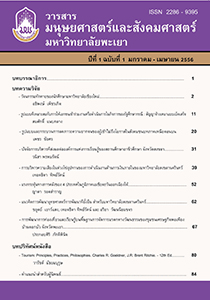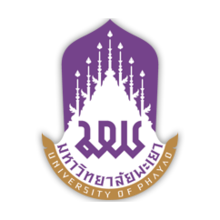รูปแบบและกระบวนการลดภาวะความยากจนของผู้เข้าไม่ถึงโอกาสในสังคมชนบทภาคเหนือตอนบน
Keywords:
ภาวะความยากจน, ผู้เข้าไม่ถึงโอกาสในสังคม, รูปแบบและกระบวนการ, การกล่อมเกลาทางสังคม, Poverty Reduction, Disadvantaged People in the Rural Societies, Patterns and Procedures, SocializationAbstract
งานวิจัยครั้งนี้มีวัตถุประสงค์เพื่อ 1) ศึกษาภาวะความยากจนของผู้เข้าไม่ถึงโอกาสในสังคมชนบทภาคเหนือตอนบน 2) ศึกษาปัจจัยที่ส่งผลต่อภาวะความยากจนของผู้เข้าไม่ถึงโอกาสในสังคมชนบทภาคเหนือตอนบน 3) ศึกษารูปแบบและกระบวนการลดภาวะความยากจนของผู้เข้าไม่ถึงโอกาสในสังคมชนบทภาคเหนือตอนบน และ 4) กำหนดยุทธศาสตร์การนำรูปแบบและกระบวนการไปใช้ลดภาวะความยากจนของผู้เข้าไม่ถึงโอกาสในสังคมชนบทภาคเหนือตอนบน วิธีการวิจัยใช้ทั้งเชิงปริมาณและเชิงคุณภาพ เครื่องมือที่ใช้ในการวิจัยประกอบด้วย การสนทนากลุ่ม, ประชุมกระบวนการ A-I-C, แบบสอบถามข้อมูลทั่วไปและปัจจัยที่ส่งผลต่อความยากจน, ประชุมเชิงปฏิบัติการ, แบบสำรวจ, การประชุมระดมความคิดเห็นด้วยเทคนิค SWOT Analysis และประเมินยุทธศาสตร์ ส่วนการวิเคราะห์ข้อมูลใช้ค่าสถิติ ร้อยละ ความถี่และวิเคราะห์การถดถอยพหุคูณ (Multiple Regression Analysis)
ผลการวิจัยสรุปได้ดังนี้
1. สภาวะทั่วไป ตำบลเมืองนะพื้นที่ติดต่อกับสาธารณรัฐแห่งสหภาพพม่า มีประชากรหลายชาติพันธุ์ เช่น ไทยใหญ่ (เงี้ยว) อีก้อ (อาข่า) ลีซอ มูเซอ คะฉิ่น จีนฮ่อ ละว้าและกะเหรี่ยง ชายแดนมีปัญหาเกี่ยวกับ ความไม่มั่นคงปลอดภัย การคมนาคม ยาเสพติด สิทธิและความเสมอภาค ความเหลื่อมล้ำทางชาติพันธุ์ การเข้าถึงสาธารณูปโภคขั้นพื้นฐานสภาพทางเศรษฐกิจ อาชีพการเกษตรส่วนใหญ่ปลูกพืชเชิงเดี่ยว มีปัญหารายได้ที่ไม่แน่นอน ภาระค่าใช้จ่ายสูง ผลผลิตราคาตกต่ำ
2.ปัจจัยที่ส่งผลต่อภาวะความยากจนของผู้เข้าไม่ถึงโอกาสในสังคมชนบทภาคเหนือตอนบน พบว่า ปัจจัยทางสังคมมี 3 ปัจจัย ได้แก่ การสะสมทุน (X4) สิทธิโอกาสทางการเมือง เศรษฐกิจและสังคม (X5) ภาระทางการเงิน (X2) ที่ส่งผลต่อรายได้ หรือภาวะความยากจน (Y1) โดยที่ปัจจัยสะสมทุน ( X4) ประกอบด้วยการไม่มีทรัพย์สินที่ก่อให้เกิดรายได้ ขาดการประหยัด อดออม มีทรัพย์สินมูลค่าต่ำ ไม่มีแหล่งทรัพยากรธรรมชาติ ไม่มีกลุ่ม/องค์กรการเงินในชุมชน ส่งผลต่อรายได้ซึ่งเป็นตัววัดภาวะความยากจนมากที่สุด ทั้งนี้ สามารถเขียนสมการพยากรณ์ในรูปคะแนนดิบ Y = 3.243 + .334 X4 + .297X5 + .326 X2 และสมการในรูปคะแนนมาตรฐาน คือ = .245 X4 + .166X5 + .153X2
3.รูปแบบการลดภาวะความยากจนของผู้เข้าไม่ถึงโอกาสในสังคมชนบทภาคเหนือตอนบน โดยจัดตั้งสถาบันการเงินชุมชน ส่งเสริมการออม การระดมหุ้น การรับฝากและการให้สินเชื่อสนับสนุน อาชีพ พัฒนาคุณภาพชีวิต จัดอบรมเศรษฐกิจพอเพียงและลด ละ เลิก ค่อยปรับเปลี่ยนแนวคิด พฤติกรรมผ่านกระบวนการกล่อมเกลาทางสังคมจัดทำกิจกรรมหลังอบรม สร้างความสัมพันธ์ สร้างเครือข่าย เปิดโอกาสให้สมาชิก เข้าทำกิจกรรมร่วมกันการพึ่งพากัน ลดความแปลกแยก มีการให้อภัยและช่วยเหลือกัน สังคมจึงจะน่าอยู่อย่างยั่งยืน
4.กำหนดยุทธศาสตร์การนำรูปแบบและกระบวนการไปใช้ลดภาวะความยากจนของผู้เข้าไม่ถึงโอกาสในสังคมชนบทภาคเหนือตอนบน เป็นการวิเคราะห์ศักยภาพหน่วยงานรับผิดชอบจัดตั้งสถาบันการเงินชุมชนและกำหนดยุทธศาสตร์การพัฒนา ปรับใช้ในการบริหารจัดการ ผลการประเมินและกำหนดค่าคะแนนวิเคราะห์มีค่าคะแนนถ่วงน้ำหนักสูงสุดอยู่ระหว่างจุดแข็งและโอกาส
สรุปได้ว่า สภาวะแวดล้อมการจัดตั้งสถาบันการเงินได้รับการสนับสนุนจากเทศบาล สถาบันการเงินและหน่วยงานต่าง ๆ ให้การสนับสนุนอยู่ในสถานการณ์ดาวรุ่ง เป็นการจัดทำแผนยุทธศาสตร์เชิงรุกหรือกลยุทธ์เพื่อความเจริญก้าวหน้า (Growth Strategy) ซึ่งปัจจัยเชิงบวกหรือปัจจัยภายในที่เป็นจุดแข็งคือ เจ้าหน้าที่ ทีมงาน มีความรู้ด้านบัญชี การเงินซึ่งเป็นความสำคัญของการจัดตั้งสถาบันการเงิน รองลงมาเป็นความพร้อมและทุ่มเทสูงมีลักษณะความเป็นผู้นำ เสียสละ อดทนของคณะกรรมการ และการแบ่งงานรับผิดชอบชัดเจนในส่วนของการจัดตั้งสถาบันทั้งได้ผ่านการอบรมมาพอสมควรมีเป้าหมายให้คนมีคุณภาพชีวิตที่ดี พึ่งพาตนเองได้ตามแนวปรัชญาเศรษฐกิจพอเพียง ดังนี้
ยุทธศาสตร์ที่ 1 ยุทธศาสตร์การส่งเสริมความรู้การใช้ชีวิตตามแนวเศรษฐกิจพอเพียง
ยุทธศาสตร์ที่ 2 ยุทธศาสตร์การส่งเสริมความรู้ อบรมอาชีพ
ยุทธศาสตร์ที่ 3 ยุทธศาสตร์เสริมสร้างความเข้มแข็งองค์กรการเงินชุมชนและกลุ่มสมาชิก
ซึ่งจากการประเมินยุทธศาสตร์โดยผู้เชี่ยวชาญมีความเป็นไปได้เหมาะสมและสอดคล้องกับสภาพสภาพแวดล้อมสามารถนำมาใช้ได้ภายใต้ทรัพยากรที่มีอยู่และมีโอกาสประสบความสำเร็จ
Patterns and Procedures for Poverty Reduction of the Disadvantaged People in the Rural Societies of Upper Northern Region
Petch Chaisorn
Education and Social Development, Faculty of Education, Chiangrai Rajabhat University
This study aimed 1) to examine the poverty state of the disadvantaged people in approaching the social service opportunities, 2) to investigate the factors influencing the poverty of the people who lacked opportunities in reaching social services, 3) to scrutinize the patterns and strategies for poverty reduction of the people who lacked opportunity in reaching social services, and 4) to recommend the patterns and strategies for poverty reduction of the people who lacked opportunity in social services in the rural communities of the upper northern region. The study design was qualitative research. The instruments included: group conversations, A-I-C meeting process, the questionnaires on general information and the factors influencing the poverty, operational workshops, brainstorming procedures based on SWOT Analysis, and the evaluation of strategies. The obtained data were analyzed by percentage, frequency, and Multiple Regression Analysis.
The findings of the study were as follows:
1.On the general state, Muang Na Sub-district is situated close to Myanmar as the home for many ethnic minority groups – Tai Yai (Ngiew), Lisu, Muser, Kachin, Haw Chinese, Lawa, and Karen. The problems found in the border areas included: insecurity, transportation, drugs and narcotics, human rights and equality, discrimination in ethnicities, services of basic public utility, and economic status. Moreover, most of the farmers grew only monoculture plants and they had uncertain income problem with high expenditure and low priced products.
2.There were 3 factors influencing the poverty of the people who lacked opportunities in social services in the rural communities of the upper northern region. These factors: capital cumulative (X4), the right in political, economic and social activities (X5), and financial responsibility (X2), strongly affected the poverty (Y1). The capital cumulative (X4) comprised: the lack of property which created incomes, the lack of saving with low priced property, the lack of natural resources, and the lack of working groups or organizations. All of these factors mostly influenced the poverty. And these can be shown in the predictive proportion of the raw scores as follows: Y = 3.243 + .334 X4 + .297X5 + .326 X2, and the proportion in the form of standard score as follows: = .245 X4 + .166X5 + .153X2.
3.The patterns for poverty reduction of the disadvantaged people in approaching social services in the rural communities of the upper northern region included: the establishment of community financial institution, the promotion of saving, share drawing, deposition and credibility for occupational support, quality of life development, training on self-sufficiency economy, reduction, discarding, eradication and changing attitudes and behaviors through social rehabilitation process, organizing activities after training, interpersonal relationship building, networking, opening opportunity for the members to the activity participation, the promotion of inter-reliability, the reduction of discrimination and conflict, and the support of forgiving and inter-assistance. With these patterns and strategies, the society would be developed sustainably.
4.The application of patterns and strategies for poverty reduction of the disadvantaged people in approaching social services appeared in the forms of the analysis of the capability of the organization, establishment of community financial institution, and setting up the strategies for development and the adaptation for work management. The results of evaluation and score setting appeared that the highest score weighing was between the strength and opportunity, which could be concluded that the situation of establishing financial institution was promoted by the municipalities, financial institutions, and other organizations which supported the activities at a blooming level. These activities were the growth strategy planning which was counted as positive or internal factors which contained the most strength: officials, working team, and knowledge of accounting which were counted important for financial institution establishment. The second rank of strengths included: goo preparation and determination of the leadership characteristics, devotion, endurance of the committee, the clear assignment of responsibility in the financial institution, sufficient training experience, and the goals for developing quality of life as well as the self-reliance in accordance with the self-sufficiency philosophy which included: the first strategy: the enhancement of knowledge of life in regards to the sufficiency economy philosophy; the second strategy: the promotion of knowledge building and occupational training; and the third strategy: the strengthening of community financial institution and its members.
Additionally, the evaluation by the specialists appeared that the patterns and strategies for poverty reduction were feasible for application and appropriate for the environment which could be used under the remaining resources and they would be successful in operation.
Downloads
How to Cite
Issue
Section
License
ผู้นิพนธ์ต้องรับผิดชอบข้อความในบทนิพนธ์ของตน มหาวิทยาลัยพะเยาไม่จำเป็นต้องเห็นด้วยกับบทความที่ตีพิมพ์เสมอไป ผู้สนใจสามารถคัดลอก และนำไปใช้ได้ แต่จะต้องขออนุมัติเจ้าของ และได้รับการอนุมัติเป็นลายลักษณ์อักษรก่อน พร้อมกับมีการอ้างอิงและกล่าวคำขอบคุณให้ถูกต้องด้วย
The authors are themselves responsible for their contents. Signed articles may not always reflect the opinion of University of Phayao. The articles can be reproduced and reprinted, provided that permission is given by the authors and acknowledgement must be given.








